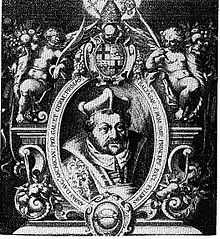Balthasar von Dernbach

Balthasar von Dernbach (1548 – 16 March 1606), was a Benedictine monk of Fulda monastery and its Prince-Abbot from 1570 to 1606.
Family
Balthasar was born into a branch (called Graul) of the von Dernbach family, a family of knights traceable to the 13th century in the vicinity of Giessen and Herborn as liegemen of the landgraves of Hesse.
Born in 1548 in Wiesenfeld, Hesse, Balthasar was the youngest son among the fifteen children of Peter von Dernbach and his wife Clara Klauer von und zu Wohra. Balthasar always spelled his name as "Dermbach".
Balthasar was baptized into the Lutheran church, though his father's religious leanings have been described as either "staunchly Lutheran" and the "only Catholic" in Hesse. A liegeman of Philip I, Landgrave of Hesse, Peter Dernbach fought in the Schmalkaldic War of 1546/47 despite adopting a critical attitude towards Philip's religious policies and has warned of the war.
Fulda monastery
When Balthasar's father died in 1560, his mother sent the 12-year-old youth to Fulda monastery, where her brother, Wilhelm Hartmann Klauer von und zu Wohra, was prince-abbot. There, Balthasar was raised a Catholic and in 1566 he was ordained a priest in Würzburg. In 1570, he was elected his uncle's successor as prince-abbot and confirmed in that position by Pope Pius V.
As abbot, Balthasar helped his brothers Otto, Melchior and Wilhelm to high offices: Otto became marshall and provost at Petersberg, Melchior an court marshall, bailiff at Brückenau and imperial counsellor, and William commander of the joined the Teutonic Knights at Kapfenburg und Oettingen. Melchior's son Peter Philip entered the service of the Prince-Bishopric of Bamberg and later became Prince-Bishop of Bamberg and of Würzburg.[1]
Counter-Reformation
Balthasar immediately adopted a policy of counter-reformation; in 1571 he called in the Jesuits to found a school and college. He insisted that the members of the chapter should return to a monastic form of life. Whereas his predecessors had tolerated Protestantism, resulting in most of the citizens of Fulda and the knights and a large party of the countryside professing Lutheranism, Balthasar ordered his subjects either to return to the Catholic faith or leave his territories.
Exile and return
These measures were resisted by the chapter, the magistrates and the knights. After Balthasar repeatedly ignored threats of violence, the knights allied themselves to Julius Echter von Mespelbrunn, prince-bishop of neighbouring Würzburg. In 1576, the combined opposition forced Balthasar at Hammelburg to sign a letter of abdication and made Julius Echter administrator on the condition that he would tolerate the knights' religion.
Balthasar fled to the Archbishop of Mainz, who gave him Castle Bieberstein as residence. Immediately after his flight, Balthasar had revoked his abdication and now sent complaints to Emperor Maximilian II and Pope Gregory XIII to be reinstated. The Pope threatened Julius Echter with excommunication if he refused to relinquish his claim to Fulda, but Echter insisted on the matter being settled by a lawsuit, which was to last 26 years. In 1602, the Aulic Council reinstated Balthasar and sentenced the chapter, the knights and the cities to pay a fine and the expenses of the proceedings. Upon his return, Balthasar continued his policy of counter-reformation and achieved a complete restoration of Catholicism in the city and the principality.
Witch trials
After 1602, he also ordered witch trials. These were presided over by Balthasar Nuss, who had attached himself to the abbot during his exile and now was appointed Zentgraf and Malefizmeister, and resulted in the death of approximately 250 people.
Literature
- Friedrich Wilhelm Bautz (1975). "Balthasar von Dernbach". In Bautz, Friedrich Wilhelm. Biographisch-Bibliographisches Kirchenlexikon (BBKL) (in German) 1. Hamm: Bautz. col. 359. ISBN 3-88309-013-1.
- Wolfgang Breul in: 200 Jahre evangelische Gemeinde in Fulda. = 200 Jahre evangelische Kirchengemeinde in Fulda. Evangelische Gemeinde, Fulda 2003, S. 15–26.
- Karl Eder: Die Kirche im Zeitalter des konfessionellen Absolutismus. (1555–1648) (= Kirchengeschichte. Bd. 3, Hälfte 2). Herder, Freiburg 1949, S. 69, 295f.
- Heinrich Heppe: Die Restauration des Katholizismus in Fulda, auf dem Eichsfelde und in Würzburg. Elwert, Marburg 1850, Digitalisat.
- Josef Leinweber: Die Fuldaer Äbte und Bischöfe. Knecht, Frankfurt am Main 1989, ISBN 3-7820-0585-6.
- Horst W. Müller: Dernbach und die „von Dernbach“. In: Hinterländer Geschichtsblätter. Bd. 84, Nr. 3, 2005, ISSN 0018-196X, S. 137–141, Nr. 4, S. 149–152; Bd. 85, 2006, Nr. 1, S. 153–155, Nr. 2, S. 162–167.
- Otto Schaffrath: Fürstabt Balthasar von Dermbach und seine Zeit. Studien zur Geschichte der Gegenreformation in Fulda (= Veröffentlichung des Fuldaer Geschichtsvereins. Bd. 44, ZDB-ID 517272-x). Parzeller, Fulda 1967, mit umfangreicher Literaturübersicht.
References
- ↑ Horst W. Müller: Dernbach und die „von Dernbach“. 2005–2006.
| Catholic Church titles | ||
|---|---|---|
| Preceded by Wilhelm Hartmann Klauer zu Wohra |
Prince-Abbot of Fulda 1570–1606 |
Succeeded by Johann Friedrich von Schwalbach |
|